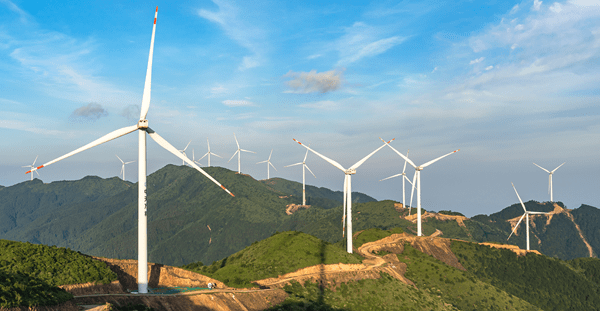Resilience experts Carly Foster and Edgar Westerhof discuss the most significant resilience gains from the past year and the ways they could shape resilience planning in 2020.
The need to improve resilience nationwide is evident—look no further than the California wildfires, Houston floods, population migrations, and utility cyberattacks for proof. But, amidst the challenges of 2019, the U.S. saw individuals and organizations alike advocating for positive change.
More civil leaders, businesses and citizens are making resilience a top priority in 2020. They’re strategizing ways to build equitable, healthy environments that can withstand resilience shocks (e.g. major flood events) and stresses (e.g. long-term economic disparities).
What might the increased attention mean for U.S. resilience long-term? Two of our resilience leaders – Carly Foster and Edgar Westerhof – sat down to explore how the landscape evolved in 2019 and what could be in store for 2020.
What notable resilience gains did the U.S. make in 2019?
EW: There’s a paradigm shift happening. Understanding climate risk and vulnerabilities became a visible priority for more local, state, and federal governance leaders. They’re planning for long-term effects of rising sea levels, severe weather events, and aging infrastructure.
CF: I’m seeing the shift Edgar is talking about across sectors and at multiple scales. From conversations about shifting asset management approaches at ports to a more systems-based approach, to developers and business owners getting together to coordinate private resilience strategies along the waterfront in Boston, to massive state-wide efforts in Louisiana to adjust how they approach the flow of water through communities.
What makes these gains so important?
CF: It feels like a seismic shift in awareness. It doesn’t matter whether you’re a schoolteacher, truck driver, or the executive director of a wastewater treatment facility—we’ll all be affected at some point or another, whether the effects last a month or a decade. There is also increased awareness of what we need in order to effectively take action: We need capacity in the form of human, financial, technological resources; capability in the form of skills and decision-making power; alignment of responsibility and authority; and cooperative or collective action. And we must take these actions with equity in the forefront of our minds. Addressing these needs will create lasting change.
EW: Yes! Resilience planning done right creates a situation where the whole is greater than the sum of its parts. That will take a move away from asset-level thinking and into systems-level thinking. Carefully assessing the entire system, including aspects like mobility, energy and ecology, helps stakeholders see benefits and costs clearly. That’s critical to bankability.
You can look at Rotterdam or Copenhagen, where leaders have been working on climate challenges for some time. They understood that a systematic integrated approach for connecting scales and stimulating multifunctional processes increases the value of adaptation.
Are there any areas of resilience that the U.S. should be focusing on in 2020? Why?
EW: Using open source data can help cities stay prepared. Early warning systems can allow faster, more accurate emergency responses to extreme weather events and natural disasters. Smart technologies can monitor system performance in real-time, and augmented reality tools could allow teams to remotely investigate sites and make changes.
CF: The root of all wise decision-making is complete and accurate information. We have made some giant leaps in big data processing, but these assessments will not be any good if the data is incomplete, outdated or inaccurate. We need to be asking what existing data gathering mechanisms can be leveraged to accomplish more, and how we can gather that data more quickly in the face of a changing risk context.
EW: As far as vulnerabilities go, the U.S. is increasingly exposed to extreme weather events in low-lying coastal urban centers. These areas are growing, adding to the stress on public utilities and aging infrastructure. Exposed communities will need to optimize limited resources. They might find that de-funding or gradually retreating in areas will increase overall resilience.
CF: The commitment to investing is a big need for 2020. I know some people see the record amounts in funds issued by Congress or the FEMA Hazard Mitigation Assistance program and think, “Carly, what more could you want?” But the fact is, as evidenced by the D+ the ASCE gave the U.S. in its infrastructure report card, we have significant unmet needs, and that’s before considering future impacts from natural hazards. Strategic spending must continue and increase. And we need to be asking questions around how this spending can maximize equity.
You each mentioned optimizing or being strategic with resources. How can organizations and individuals alike work to optimize their increased resilience spending?
CF: First, take the time needed to truly understand the risk, the root causes of why that risk has not already been alleviated, and the partners and stakeholders that could affect the implementation of solutions or could be affected by any possible solutions. Then, develop solutions that truly address the need. Solutions developed from a clear decision path are more likely to be implemented. Evaluate existing planned capital improvements projects for opportunities for adjustment. Build partnerships to leverage resources. I have worked with stakeholders who believe they have mutually exclusive priorities only to find out that the same solution could address both.
When cities are pressured to act and demonstrate their ability to act, they can inadvertently sacrifice the technical analyses for beautifully drawn plans that may not address the need. This could mean developing detailed resilience strategies without current risk modeling or making assessments with inadequate, old, or even erroneous data. These beautiful plans can create an illusion of more certainty than is available and carry the risk of overlooking problems or leaving gaping holes in a strategy, or worse – exacerbating resilience challenges in other areas.
Long-term success takes data sourcing and technical analysis, as well as engagement of community members, subject matter experts, and decision makers. We must put in hard work to answer the right questions and to develop solutions with positive impact across generations.
EW: There is also no time to lose. If vulnerable communities do not act, market forces will dictate their future. We need efficient approaches to advance the time between incubation and implementation of solutions. I think the Climate Ready Boston program is a good example of this done the right way to optimize resources. They used detailed, up-to-date models to perform thorough assessments around their strategy. Quantifying the benefits using data helped create a mechanism for positive change, so people can trust the plan in place.
One thing is clear: We need efficient approaches to advance the time between incubation and implementation of solutions. There really is no time to lose! There are systems that can help expedite the analyses of information and optimize spending across complex projects. Organizations can use them to avoid chaotic disruptions.
What will be the story of U.S. resilience in 2020?
EW: Waterfronts and sea level rise need to be a story in 2020. Our waterfronts aren’t here to stay, and sea level rise is unfolding like a slow-moving disaster. Typically, the areas and assets that get adapted would be determined by market responses. We need to engage in conversations around the new policies needed to ensure vulnerable and low-income communities get the attention and resources they deserve.
CF: That’s true. Existing regulatory and governance structures were not necessarily developed with a changing risk context or accelerating speed of urbanization and demographic shifts in mind. 2020 should see a re-evaluation of how these systems might need to change to help build resilience. For example, are Brownfield capping requirements adequate? Do environmental regulations related to fill work as intended? Are the capital improvements I planned a decade ago going to meet my community’s changing needs? Do we have the right system to ensure that everyone that could contribute to this solution can and are?
EW: All of this will be a continuous balancing act. Different regions will be developing best practices for improving resilience. I hope another story for 2020 will be about regions sharing strategies through new and existing alliances across the world. Breaking down silos between departments, sectors and organizations to develop effective, equitable solutions. It will be a story of rethinking the way we value, look at, and fund our infrastructure. We want people to take note of what agencies in Boston, San Francisco, Louisiana, Miami, New York, are doing and see how it can be used to engage their own communities and organizations.
CF: Building resilience is the most equitable and sustainable way to improve quality of life. As we enter a new decade, it’s important that the people and organizations with a stake and/or responsibility in doing so join forces and invest in solutions that put the citizen first. The U.S. cannot achieve prosperity through reactive approaches. Does this mean hard work ahead? Yes. The foundations that we build our lives and livelihoods upon moving forward will require people to change the way they think, act and feel—resilience cannot happen without it. But the social, environmental and economic benefits far exceed the effort it will take, and no one needs to go it alone.
Contact Carly or Edgar to find out about Arcadis’ resilience practice. For more resilience insights, read The Journey of City Resilience or Resilience Reimagined: Building a fit-for-future utility.





